HOME | ABOUT US | MEDIA KIT | CONTACT US | INQUIRE
HOME | ABOUT US | MEDIA KIT | CONTACT US | INQUIRE

The premise is simple enough: “My family is the most important thing to me, so why not spend every day with the people I love most, working together and succeeding together?”
If only life in a family business were quite that simple. Consider just a few of the issues woven into that dynamic. For one, you’ll never live by the family counselor’s “don’t take work home” guidance—in a small enterprise, the work is with you whether you’re at your office desk or the kitchen table. For another, you run the risk of internecine war with every top-down directive that could chafe a spouse, a sibling, a child, a parent, a cousin or an in-law. Every discussion over business finance or purchases could trigger a family feud; every missed deadline has the potential for a sleep-on-the-couch outcome.
The fact is, family-owned businesses aren’t just a world apart, they constitute another universe entirely. Which makes the successful ones deserving of our respect and admiration. For although policy-makers disagree on how much net new job creation can be attributed to small business, especially beyond the rapid-growth phase of a start-up, there’s little doubt that these enterprises account for a large portion of that hiring.
Many factors set high-performing family-owned companies apart. To paraphrase Tolstoy, all successful family businesses, in key performance areas, are alike; each unsuccessful one fails in its own way.
With that, Ingram’s presents its 2016 Family Business Awards, spotlighting the ways these businesses tread the path to success, and exploring tactics that have helped them avoid missteps on the way. We hope their examples will provide inspiration and guidance for all who aspire to the sam levels of achievement.
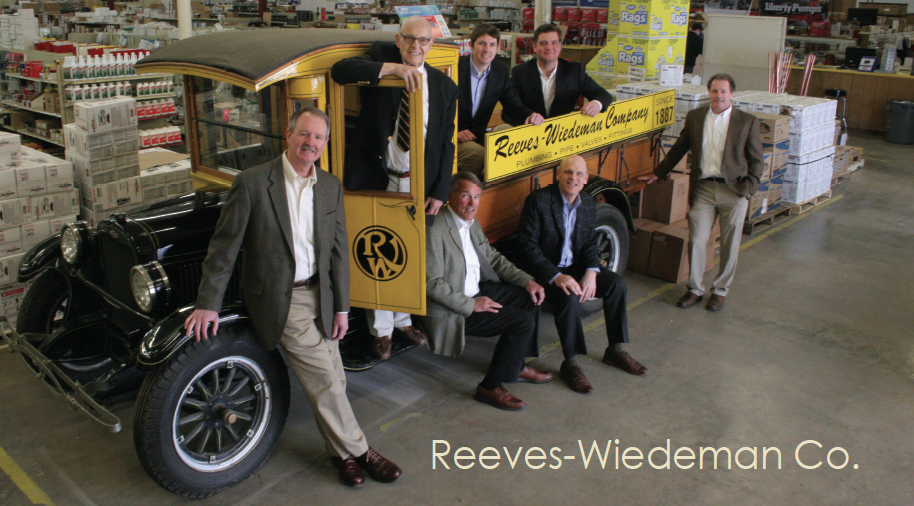 Left to right: Wally Wiedeman, retired Executive Vice President; Ted A. Wiedeman, retired CEO; Ted G. Wiedeman, CEO; Kurt Wiedeman, CFO; Bill Wiedeman, Vice President-Operations. In the truck: Luke Wiedeman, Purchasing Manager; Rob Long, Manager, Downtown Kansas City location.
Left to right: Wally Wiedeman, retired Executive Vice President; Ted A. Wiedeman, retired CEO; Ted G. Wiedeman, CEO; Kurt Wiedeman, CFO; Bill Wiedeman, Vice President-Operations. In the truck: Luke Wiedeman, Purchasing Manager; Rob Long, Manager, Downtown Kansas City location.
The story of Reeves-Wiedeman Co. is actually a tale of two family businesses: The first was founded in 1887 by the Reeves brothers, William, Edward and Louis, and from Gray Plumbing & Heating, Louis Reeves rolled the dice on his own venture: Reeves Supply Co. That was in 1897, and the next 43 years marked an all-Reeves operation.
In 1940, Louis Reeves was ready to retire, but had no one to take over the family business until a member of his staff stepped up: Wally Wiedeman, a Chicago native who had worked his way up the company for the previous quarter-century. Thus was born Reeves-Wiedeman, which continues today with a third generation at the helm and a fourth learning the ropes. With 75 employees, the plumbing-supplies wholesaler has found success by avoiding the complications of managerial layering.
“We are a flat organization,” says Ted Wiedeman, the current CEO. “Family members fill the executive roles where possible and are responsible for key areas. We don’t have sales reps— family members lead the effort and our managers fill in as needed. Many of our customers have done business with our family company for generations.”
The need for superior customer service is a given, but to secure long-term success, he says, “we do review our mission each year and try to identify specific areas where we can improve and set objectives at the beginning of the year that the family and the entire organization focuses on.” This year, for example, that included a focus on improving the company’s value proposition, improving inventory management, finding better ways to manage and allocate people and resources across 18 offices in an arc from Maryville, Mo., to Manhattan and Emporia, Kan.
“We have always had a planning process,” Wiedeman says, but “it is more formal now. In recent years we have become more successful leading, and driving the change through the organization and achieving measurable results, but naming and executing specific things.”
The model for this family business entails giving every member of the clan an opportunity to work the most difficult jobs, Wiedeman says. “They will learn more about the business and vice versa, ultimately each family member needs to be capable for whatever area he works in and compensated fairly like any other company.”
Only when family members show significant capability in a variety of job situations, he said, should they have the opportunity for ownership. “It is not necessary to pay every family member equally; it’s unfair to the high-performers, and you risk losing them,” Wiedeman said. “It is difficult to attract talented, capable family into the business in the future if they can’t see their career path, and if you don’t give them opportunities to succeed or fail. At the end of the day they will know, and you will know where they fit in.”
Difficult situations are going to come up in any business, family-owned or not, he said. But the bottom line is, it must be run like a business. “Watch the numbers and make sure you are financially successful whatever business you’re in,” Wiedeman says. “Being successful is the most important way to insure the continuation of the business and to continually bring in the next generation of family to take the business to the next level.”
And that generates a level of personal fulfillment that simply can’t be found in other business-ownership structures. “Family members have the satisfaction of being a part of history, continuing a tradition locally and even nationally over generations,” Wiedeman says. “In our case, we have customers that also share this same pride since many of their businesses have been around as long as we have. This tradition is one more unique thing we have over our competition.”
 (l-r) James Bixby, Asst. Vice President; Philip Bixby, Chairman, CEO & President; Web Bixby, Executive Vice President and Vice Chairman; Blake Bixby, Business Analyst. Portraits (l-r) Walter E. “Walt” Bixby (President 1990-1998), Walter E. “Ed” Bixby (Pres. 1939-1964), J.R. “Joe” Bixby (Pres. 1964-1990).
(l-r) James Bixby, Asst. Vice President; Philip Bixby, Chairman, CEO & President; Web Bixby, Executive Vice President and Vice Chairman; Blake Bixby, Business Analyst. Portraits (l-r) Walter E. “Walt” Bixby (President 1990-1998), Walter E. “Ed” Bixby (Pres. 1939-1964), J.R. “Joe” Bixby (Pres. 1964-1990).
Success into a fourth and fifth generation of a family business, says Web Bixby, is a bit of a paradox: “Family business leaders need to put growth first over the generational concept,” says the vice chairman and executive vice president of Kansas City Life Insurance. “Without growth and long-term success, there isn’t an organization to leave to the generations of the future. At the same time, family always should come first.”
And with that, he offers this advice to those who work with family, or hope to one day: “Remain committed to growing the business today, but remember the family runs the business— the business doesn’t run the family.”
He and his brother, Philip, the chairman, CEO and president, are the great-grandsons of J.B. Reynolds who joined the company just a few years after its founding in 1895. Web’s sons, James and Blake, are fifth-generation Bixbys working there. But unlike most other family companies, this one stands out because its stock is publicly traded. That, however, doesn’t change the fundamentals needed to ensure long-term growth.
“As each generation has come and gone, we’ve maintained success and growth, which I think, has made Kansas City Life and our family one in the same in many respects,” Philip Bixby said. “Today, we’re just as committed as we’ve always been. People support our consistent, generational approach. It’s almost like a ‘quiet calming’ effect at our home office.”
The company’s associates, he said, know that the leadership is 100 percent committed to this company, which in turn “fosters a level of expectation to treat our customers as part of our extended family,” he said.
“We also know that to succeed, you need to hire great people. We look for people that fit the mission and values of Kansas City Life and put them in a position to succeed. Our family helped build Kansas City Life into what it is today. But it’s fair to say that we couldn’t have done it alone. So we understand how important it is to get our associates acclimated to our culture, our systematic approach to the business and our methodologies. How do we know this is working? “Our longevity as a company, for one thing. But we also have so many tenured associates as well, many who are also generational. We have so many employees who have worked here for decades. Fathers and sons. Mothers and daughters. Husbands and wives. There are many connections here.
With revenues topping $440 million last year, it’s a big company, and one that reached that scale not by an inward focus on family, but by paying attention to employees and customers. “To succeed, you need to hire great people,” Web Bixby said. “We look for people that fit the mission and values of Kansas City Life and put them in a position to succeed. Our family helped build Kansas City Life into what it is today. But it’s fair to say that we couldn’t have done it alone. So we understand how important it is to get our associates acclimated to our culture, our systematic approach to the business and our methodologies.”
All of which rely on a vision articulated at the top. “From pure leadership, we practice a holistic approach, where we analyze every situation from top to bottom to ensure we have the right solutions or objectives on the table,” Philip Bixby said. “We operate in a very competitive marketplace, so without a clear vision for success, you can easily get left behind.”
Long-term success means honoring a promise made to policyholders, “to guide this company with a long-term perspective so that our policyholders can depend on us today and tomorrow, no matter what the future holds,” Philip said. “All of our leaders, not just members of our family, understand that we operate with this expectation day in and day out.”
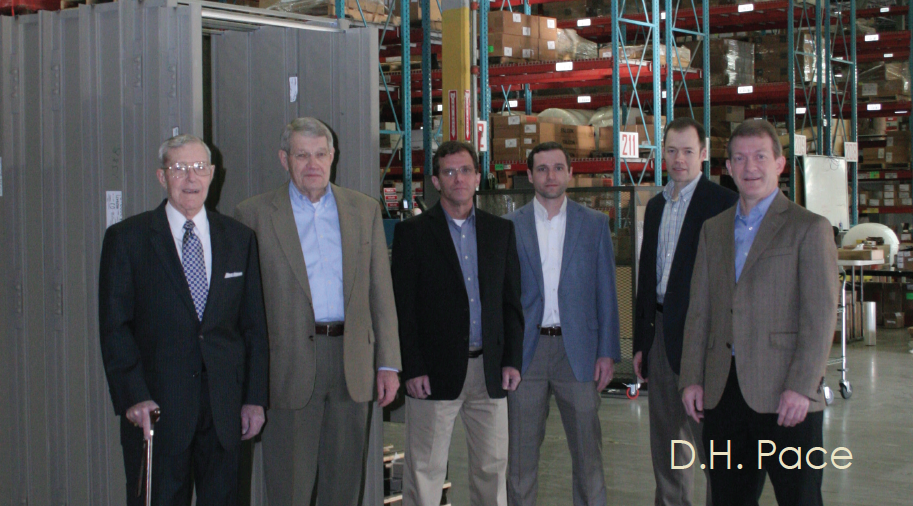 (l-r) Ed Newcomer, Chairman Emeritus; Nelson Newcomer, Executive Vice President; Ray Newcomer, Board Member; Alex Newcomer, Operations Manager; Brad Newcomer, Sr. VP-Process Improvement; Rex Newcomer, CEO. Not pictured: Elizabeth Kelamis, Robert Newcomer, board members.
(l-r) Ed Newcomer, Chairman Emeritus; Nelson Newcomer, Executive Vice President; Ray Newcomer, Board Member; Alex Newcomer, Operations Manager; Brad Newcomer, Sr. VP-Process Improvement; Rex Newcomer, CEO. Not pictured: Elizabeth Kelamis, Robert Newcomer, board members.
Companies, like families, don’t just grow, they evolve. And each new wave brings new complexities. When you get into a second and third generation of ownership, with a fourth in the wings, and you’re bucking $300 million in revenues, the pleasant informality of small family business logically gives way to structures that help manage the complexities of a family workplace dynamic. Nowhere is that as evident as at D.H. Pace, maker of commercial and residential doorways. Here’s what works at the Olathe-based company:
“First and foremost, we established a shared vision within the family by adopting a Family Business Mission Statement and a set of Family Business Principles that serve to guide our actions and relationships,” says CEO Rex Newcomer. “Even though some family members live far away, we strive to meet periodically to provide meaningful updates on the company and renew our commitment to these principles.” Likewise, the company’s board includes balanced representation from each stakeholder group, Newcomer says: out-side members with specialized expertise, members from each branch of the family, and key business managers.
Long known for the red ribbon and the Overhead Door Co. flag it flies, the company is expanding its corporate identity by promoting the D.H. Pace name, a reflection of its work with more than garage doors. What won’t change, Newcomer says, is a tested approach to integrating family into the operation.
Over the years, he said, “As the next generation reached working age, we refined our approach to the employment of family members.” That means encouraging those who live close to a company facility to work part-time while still in school, to gain solid work experience, learn more about the business and build relationships that will be vital for their careers. Then, Newcomer says, “we apply a strictly business-first approach to employment. “We encourage family members to seek initial employment elsewhere to gain valuable work experience outside the family business. If they subsequently apply for employment they compete against non-family candidates with the most qualified candidate selected. The same approach holds true for promotions within the company. While this approach may not be appropriate for all family-owned businesses, it has served us well over the years.”
The leadership qualities needed to execute those strategies are grounded in vision, communication, patience and strength of conviction, he says, as well as in “knowing your strengths and leveraging them. Knowing your weaknesses, and surrounding yourself with people who can lead in those areas.”
For family in particular, communication is a key. His counsel to any family-owned company is to “communicate to the family. Listen to the family. Educate the family on how successful businesses operate and why so many family businesses fail. Establish principles and behavioral norms before you need to apply them. Not everyone needs to agree with everything you do—they do need to believe you have the best long-term interest of the company and family at heart, and that you are working hard to be fair-minded in your decisions.”
And it’s important not to run the business by committee. “Someone needs to be clearly in charge of the day-to-day decisions with constructive oversight by others on the larger issues,” he says.
The payoff, of course, is uniquely different from what other ownership models produce. “It is very rewarding to be part of a business with a vision for making a positive impact in the communities we serve, for our employees and their families and our family members—for today and for the benefit of the generations to follow,” Newcomer says. “A family business provides an essential foundation that makes long-term business planning possible. Our family feels blessed to have such an opportunity and we are committed to working together to make a lasting and positive impact.”
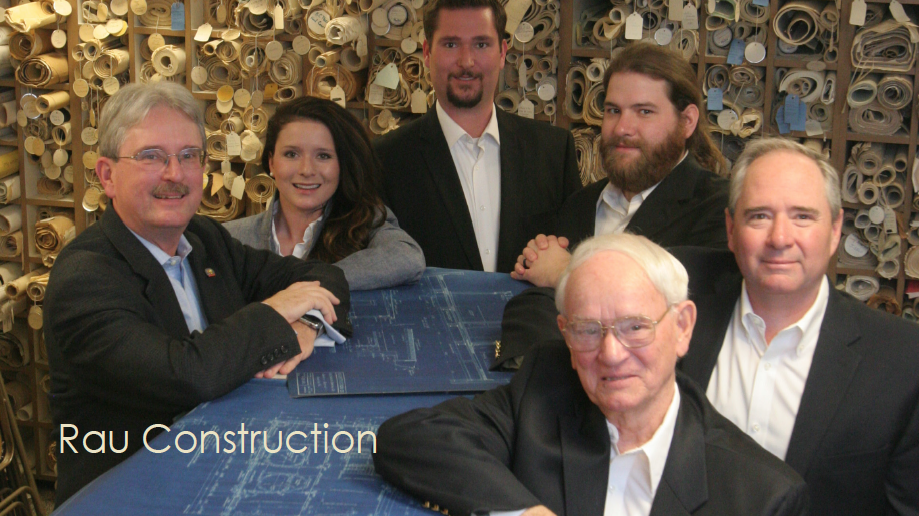 Clockwise, from left: Gus Rau Meyer; President; Alison Meyer, Project Manager; Jason Meyer, Project Manager; Andy Meyer, Project Manager; Dan Rau Meyer, Senior Vice President; Stanley Meyer, Chairman.
Clockwise, from left: Gus Rau Meyer; President; Alison Meyer, Project Manager; Jason Meyer, Project Manager; Andy Meyer, Project Manager; Dan Rau Meyer, Senior Vice President; Stanley Meyer, Chairman.
That adage about how family-owned companies hit the wall with a third generation? It’s good for a laugh around the offices of Rau Construction, which blew right through that wall a couple of generations back and now has No. 5 running the show, and No. 6 well-represented within the organization.
The leadership includes brothers Gus and Dan Rau Meyer, who bring complementary skills to the table: Gus earned his degree in civil enginering, while Dan came up from studies in environmental design and architetural engineering, both graduating from KU.
For its first 35 years, the company operated in Germany under founder Gustav Rau, who relocated it to the U.S. in 1905. Today, Rau Construction is the utility infielder of general contractors: It can move as fluidly from multifamily residential to church construction, from office to health-care and medical facilities, from education to light industrial and even historic renovations. With a suite of services that run from pre-construction consulting to on-site construction, project management and close-out, the Meyer brothers have built a company that succeeds on flexibility.
And, in a way, on one rigid value: “What has worked for us is that the people involved in the day-to-day operation of the company are the ones that get the benefits of ownership,” said Gus, the company’s president. “What I mean by that is, we don’t have any family members who get paid but aren’t involved. We think that’s important because the people involved have a sense that we’re all working together for one common result.”
That includes the occasionally dicey discussions over compensation, perhaps one of the thorniest family-business workplace issues, right up there with division of responsibilities and titles. But again, Meyer says, “those involved in compensation decisions have to be involved in the day-to-day business.”
The current family makeup consists of the brothers and three of their children: Gus’s son, Jason, who works as a project manager, and Dan’s children, Andy, an assistant project manager, and Alison. In addition, Gus’s wife, Cheryl, has worked for the company at various times, and can get pulled back in to assist with occasional tasks when needed. And they all have a seat at the table, Gus said. “No major decisions are made in a vacuum—everybody’s involved. Whether you’re right out of college and here for a week, or you’ve been here 35 years, you’re involved in the decision- making.”
It takes a certain amount of confidence to give a relative newcomer a say in decision-making before developing a detailed and nuanced understanding about how a business operates, but the Rau Meyer clan has come up with a formula for avoiding missteps.
“Our parents always taught us to get along,” Gus says. “We never learned how to fight with each other, so we’ve always been open in our discussions. I view it as everybody else has good ideas, for one, and second, they’re usually talking about things that are going to affect them more than they affect me. I hope they’ll stay with the business, but if they do, they’re going to have to live with those decisions for the next 35 or 40 years.”
A total staff of 50 employees means 10 percent of the payroll is family, still small enough to operate without formal policies regarding how family members will interact with those outside the Meyer circle. “That always has been the model,” Gus says. “Our staff has very low turnover, so people seem to enjoy working with us.”
But they try to ensure that, no matter how enjoyable, the work stops when the workday does. “One of the things I took away from my father was, we work hard, we may work long hours, but when we go home, we try our best not to talk business,” Meyer said. “It’s hard not to, but we try not to take it home and consume our home life.”
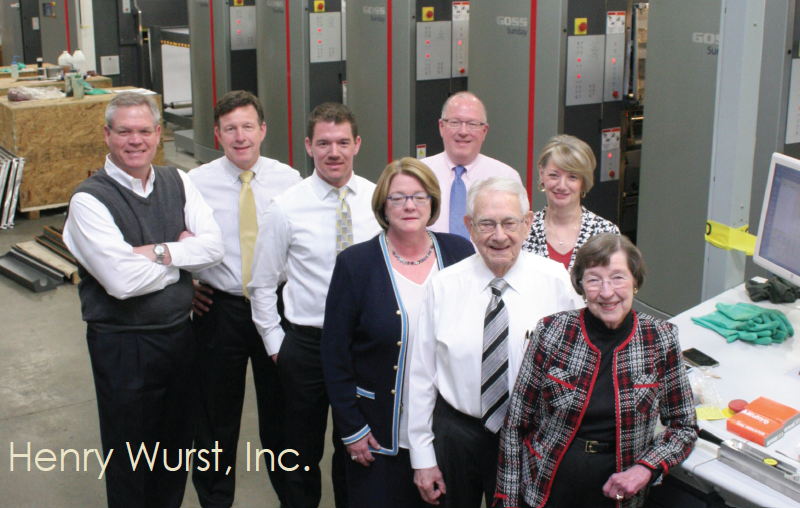 Front row (l-r): Amy Wurst, Vice President; John Wurst, Chairman; Peggy Wurst, Henry Wurst Family Foundation. Back row: Andy Hendricks, Senior Sales Executive; Tim Wurst, Director of Marketing Services; Brian Wurst, Controller; Mike Wurst, CEO; Allison Wurst, Senior Sales Executive.
Front row (l-r): Amy Wurst, Vice President; John Wurst, Chairman; Peggy Wurst, Henry Wurst Family Foundation. Back row: Andy Hendricks, Senior Sales Executive; Tim Wurst, Director of Marketing Services; Brian Wurst, Controller; Mike Wurst, CEO; Allison Wurst, Senior Sales Executive.
Mike Wurst knows printing inside and out, but when it comes to the difference between family-owned businesses and other structures, he’s good with a hammer, too, because he absolutely nails it: “In any business,” says the Henry Wurst CEO, “there are ebbs and flows, drama and conflict, successes and failures. Family businesses have all that AND the added complexities of personal family relationships.” With three generations currently working there, he says, “the family aspect is inescapable.”
Wurst represents the third generation to lead the North Kansas City-based commercial printer, sandwiched between his 85-year-old father, John, the company’s chairman, and 28-year-old Brian, the company’s controller. Also in the mix are Mike’s wife, Allison; his sister, Amy—all told, eight family members involved in everything from executive management to sales and marketing activities. The structure is not without unique challenges.
“Sometimes we all have to take a breath and realize we are all interested in the same outcome, and are on the same team,” Mike says. “Overall though, it has been fun to see the business provide challenges and opportunities for each of us to prove our professional abilities. And each generation brings their own mix of talents to the table.”
That’s been the case since Henry, John’s father, founded the company in 1937. From its commercial printing roots, it has evolved into one of the 100 largest (No. 77) printing and marketing communications companies in the nation. How does it manage the family dynamic?
“Through the years, we’ve tried to use a blend of outside perspective and consultants, as well as our own internal meetings and family gatherings,” Mike Wurst says. “We all agree that opportunities should be driven by merit, and that the family business should be a supportive environment where both family and all employees have a chance to spread their wings.”
Being into a fourth generation, he says, means that “we are beyond the cult of the entrepreneur and a single strong personality. We are more collaborative, and conscious of being inclusive and tapping the abilities of professionals outside our insular perspective.”
At this point, he says, the most significant issue very well may be whether to maintain family ownership and leadership, or ultimately to sell the business. But that decision is well down the line. For now, there’s plenty to enjoy about working with the people he loves most. “I think it is meaningful to provide an environment where all individuals have an opportunity to voice concerns, share personal challenges, and expect to be heard and helped when necessary,” Wurst said. “A family business is a luxury in that sense, to include our professional lives in the mix of our family relationships. But I would caution that in our experience, it’s crucial that family members pull their weight within the organization. Having a freeloader in the mix will poison the company culture.”
Even with all hands pulling that weight, “mixing family with business is 90 percent great—the other 10 percent comes from the realization that our family relationships are studded with business overlaps, and those can get messy and sensitive as we each encounter typical ups and downs,” Wurst says. “I’d prefer that business cycles not be be reflected in a Thanksgiving family get together, but that’s not necessarily realistic. Personally, I feel a greater sense of responsibility as CEO for getting the decisions right. After all, I want to be invited back for family Thanksgiving dinner next year, too.”
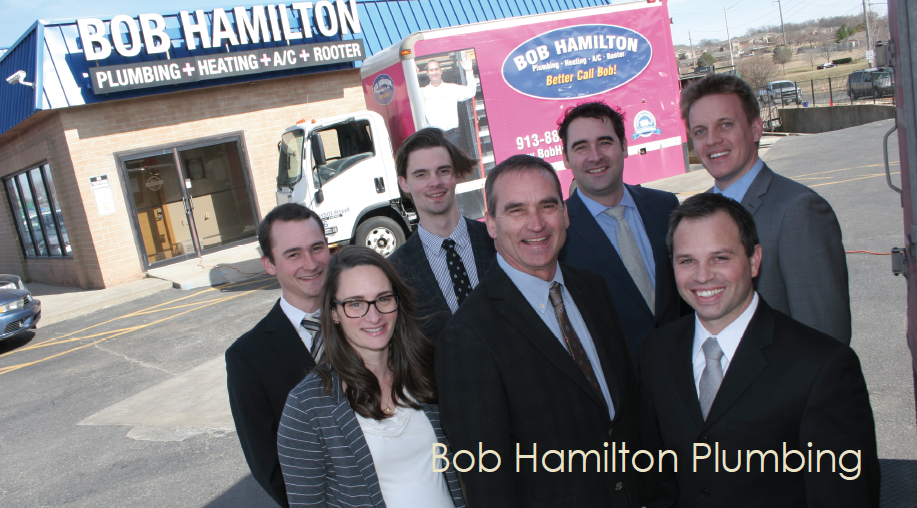
Front (l-r): Amy Threlkeld, Operations Manager; Bob Hamilton, Owner; Kurtis Threlkeld, Sales Manager; back row: Hunter Hamilton, Field Supervisor; Jon Hamilton, Senior Field Manager; Bobby Hamilton, Field Service Manager; Erik Acinger, Controller.
He’s the son of a plumber, a plumber himself, and the father of 12. So it was pre-ordained that Bob Hamilton would have the clan join in the family business once they reached working age, right?
“No, there was no real plan—I’m not a huge planner,” says the founder of the Lenexa-based company that bears his name and a service line that includes heating, air conditioning and rooter services. I can’t be knowing what they’re going to want to do with their lives: Do I have a place for them? I don’t know if I do—it just happens.”
We’ll take him at his word on that. But one look at the hive of Bob Hamilton vans and trucks buzzing around the headquarters parking lot suggests that Hamilton is doing a lot of other planning. That’s how you go from a one-man operation to a $14 million business over the course of a working lifetime.
“I started out in the truck—it was just me and my wife, and Teresa would answer the phone and tell me where to go—she still does,” Hamilton wisecracks. “Once we had a physical building, I could bring the kids in during the summer; they could cut copper, sort fittings, whatever—we started them all that way. With the girls, they would start in eighth grade, answer the phones. Amy even did dispatching when she was in eighth grade.”
That would be Amy Threlkeld, his married daughter who has also served as operations manager. She’s one of four Hamilton siblings working there, out of the six who have graduated from college at this point—the two others have careers in nursing and financial services.
In a setting with 75 employees, six members of the owner’s family and six prospective “hires” yet to finish college, questions among the non-Hamiltonians about where they fit in long-term are unavoidable, Bob says. “We do have other managers who are not family members,” he points out. “And they are super-awesome-great at what they do. They get along great with the kids. But we do a kind of poll, a question once a month: How do you like it here, what do you think we should change, on a scale of 1-10. One thing that does come back is ‘I don’t think there’s much chance of advancement for me here because my name isn’t Hamilton.’ That’s a bit concerning because we do have managers and people we promote; you don’t have to be a family member to rise up through our organization.”
In fact, the economics of the industry suggest that everyone with an eye on management roles stands an equal chance, based on merit. “Being a service tech is actually an awesome career for anybody,” Hamilton says. “If any wanted to do that, most of the kids, the boys, they could make more money in a truck then they can in their roles as a manager. As far as monetary, they could absolutely make a lot more money—they have to take a pay cut to come into the office. We offer it—we have offered it—to other people to take other positions, but they won’t do it because they can’t take the pay cut. My kids will take the pay cut, because they see the greater picture.”
So how many of the younger set—going down to age 13, and already exposed to summer duties at the company— will land there for their careers?
“That doesn’t enter my thinking at all,” Hamilton flatly declares. “The other six, I have no idea if they will work here or not, or follow a different career path.” At home, at the dinner table, he says, “it never does come up; it’s something we don’t really talk about. I just don’t know. Like I said: I’m not a huge planner … I just let it roll.”